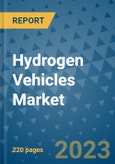The global push for sustainable transportation solutions and the need to reduce air pollution has led automakers to explore alternatives that deliver superior performance while minimizing environmental impact. Hydrogen vehicles have emerged as a viable solution with increasing government support across major economies, positioning the market for substantial growth. the analyst is set to release a comprehensive study analyzing the future growth of the global hydrogen vehicles market, highlighting the impetus from government support and favorable regulations, including the establishment of hydrogen stations.
PAFC Technology Drives Market Growth
The zero-emission and economic advantages of hydrogen vehicles have garnered significant interest from the research community. As sustainability and greenhouse gas reduction take center stage, the demand for high-performance, fuel-efficient vehicles is projected to create a favorable environment for hydrogen vehicle sales. Notably, the integration of phosphoric acid fuel cells (PAFC) in heavy commercial vehicles has gained traction and is expected to contribute significantly to the growth of the hydrogen vehicles market.Hydrogen-powered Passenger Cars Maintain Strong Sales
Hydrogen-powered passenger cars continue to thrive, driven by the demand for highly efficient vehicles for short-distance travel. While hydrogen vehicles were initially considered more suitable for longer distances typically covered by commercial vehicles, their perceived benefits in terms of customer convenience and satisfaction have enabled them to penetrate the passenger car segment more deeply. The current perception of hydrogen vehicles as superior to electric counterparts in terms of charging time and fuel efficiency is expected to drive the growth of the hydrogen vehicles market.Asia Pacific Takes the Lead as Developing Economies Pursue Zero-emission Targets
Developing economies in Asia Pacific, including China and India, are witnessing a significant increase in the adoption of hydrogen vehicles as they target rapid emission reduction and sustainable transportation solutions. India's National Thermal Power Corporation (NTPC) plans to invest in hydrogen vehicles for pilot projects, supported by industry leaders such as Tata Motors, KPIT Technologies, and Ashok Leyland. China, with government subsidies and incentives for hydrogen vehicles and fueling stations, presents a substantial opportunity for market growth, according to preliminary findings.Key Players in the Global Hydrogen Vehicles Market
The forthcoming report will provide detailed company profiles of key players in the hydrogen vehicles landscape, including BMW AG, Audi AG, Daimler AG, GM Hydrogenics, Toyota, Honda Motor Company Ltd., and Hyundai. These industry leaders are at the forefront of driving innovation and advancing the hydrogen vehicles market.Table of Contents
1. Executive Summary
2. Market Overview
3. Production Statistics, 2019 - 2022
4. Price Trends Analysis and Future Projects, 2019 - 2030
5. Global Hydrogen Vehicles Market Outlook, 2019 - 2030
6. North America Hydrogen Vehicles Market Outlook, 2019 - 2030
7. Europe Hydrogen Vehicles Market Outlook, 2019 - 2030
8. Asia Pacific Hydrogen Vehicles Market Outlook, 2019 - 2030
9. Latin America Hydrogen Vehicles Market Outlook, 2019 - 2030
10. Middle East & Africa Hydrogen Vehicles Market Outlook, 2019 - 2030
11. Competitive Landscape
12. Appendix
Companies Mentioned
- Foshan Feichi Automobile Manufacturing Co, Ltd.
- SAIC Motor Corp. Ltd.
- Ford
- Stellantis N.V.
- Sunlong Bus
- BMW AG
- GM Corp.
- Daimler AG
- Audi AG
- Toyota Motor Corporation
- Hyundai Motor Company
- FuelCell Energy Inc.
- Honda Motor Company Ltd.
- Tata Motors
Methodology

LOADING...








